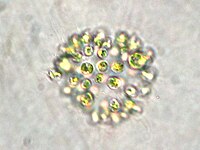
Photo from wikipedia
Harmful cyanobacterial blooms occur worldwide and pose a great threat to aquatic ecosystems and public health. The application of algicidal bacteria represents an eco-friendly strategy for controlling harmful cyanobacterial blooms;… Click to show full abstract
Harmful cyanobacterial blooms occur worldwide and pose a great threat to aquatic ecosystems and public health. The application of algicidal bacteria represents an eco-friendly strategy for controlling harmful cyanobacterial blooms; thus, searching for a high efficiency of algicidal bacteria has been becoming an important and continuous task in science. Herein, we identified a bacterial strain coded Streptomyces sp. HY with a highly algicidal activity, and investigated its algicidal efficiency and mechanism against Microcystis aeruginosa. The strain HY displayed high algicidal activity toward Microcystis aeruginosa cells, with a removal rate of 93.04% within 2 days via indirect attack. Streptomyces sp. HY also showed the ability to lyse several genera of cyanobacterial strains, including Dolichospermum, Pseudanabaena, Anabaena, and Synechocystis, whereas it showed a minor impact on the green alga Scenedesmus obliquus, demonstrating its selectivity specially for targeting cyanobacteria. Its algicidal mechanism involved damages to the photosynthesis system, morphological injury of algal cells, oxidative stress, and dysfunction of the DNA repair system. Furthermore, HY treatment reduced the expression levels of genes (mcyB and mcyD) related to microcystin biosynthesis and decreased the total content of microcystin-leucine-arginine by 79.18%. Collectively, these findings suggested that the algicidal bacteria HY is a promising candidate for harmful cyanobacterial bloom control.
Journal Title: Toxins
Year Published: 2023
Link to full text (if available)
Share on Social Media: Sign Up to like & get
recommendations!